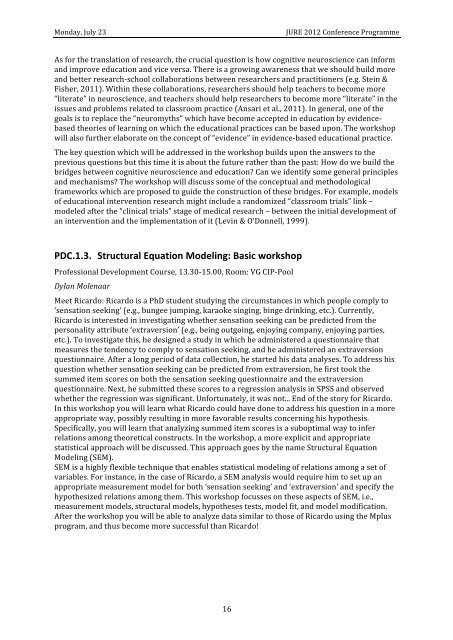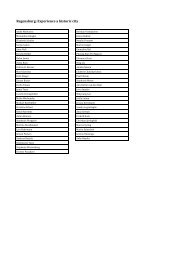JURE 2012 Programme book - EARLI Jure 2012
JURE 2012 Programme book - EARLI Jure 2012
JURE 2012 Programme book - EARLI Jure 2012
Create successful ePaper yourself
Turn your PDF publications into a flip-book with our unique Google optimized e-Paper software.
Monday, July 23 <strong>JURE</strong> <strong>2012</strong> Conference <strong>Programme</strong><br />
As for the translation of research, the crucial question is how cognitive neuroscience can inform<br />
and improve education and vice versa. There is a growing awareness that we should build more<br />
and better research-‐school collaborations between researchers and practitioners (e.g. Stein &<br />
Fisher, 2011). Within these collaborations, researchers should help teachers to become more<br />
“literate” in neuroscience, and teachers should help researchers to become more “literate” in the<br />
issues and problems related to classroom practice (Ansari et al., 2011). In general, one of the<br />
goals is to replace the “neuromyths” which have become accepted in education by evidence-‐<br />
based theories of learning on which the educational practices can be based upon. The workshop<br />
will also further elaborate on the concept of “evidence” in evidence-‐based educational practice.<br />
The key question which will be addressed in the workshop builds upon the answers to the<br />
previous questions but this time it is about the future rather than the past: How do we build the<br />
bridges between cognitive neuroscience and education? Can we identify some general principles<br />
and mechanisms? The workshop will discuss some of the conceptual and methodological<br />
frameworks which are proposed to guide the construction of these bridges. For example, models<br />
of educational intervention research might include a randomized “classroom trials” link –<br />
modeled after the “clinical trials” stage of medical research – between the initial development of<br />
an intervention and the implementation of it (Levin & O’Donnell, 1999).<br />
PDC.1.3. Structural Equation Modeling: Basic workshop<br />
Professional Development Course, 13.30-‐15.00, Room: VG CIP-‐Pool<br />
Dylan Molenaar<br />
Meet Ricardo: Ricardo is a PhD student studying the circumstances in which people comply to<br />
‘sensation seeking’ (e.g., bungee jumping, karaoke singing, binge drinking, etc.). Currently,<br />
Ricardo is interested in investigating whether sensation seeking can be predicted from the<br />
personality attribute ‘extraversion’ (e.g., being outgoing, enjoying company, enjoying parties,<br />
etc.). To investigate this, he designed a study in which he administered a questionnaire that<br />
measures the tendency to comply to sensation seeking, and he administered an extraversion<br />
questionnaire. After a long period of data collection, he started his data analyses. To address his<br />
question whether sensation seeking can be predicted from extraversion, he first took the<br />
summed item scores on both the sensation seeking questionnaire and the extraversion<br />
questionnaire. Next, he submitted these scores to a regression analysis in SPSS and observed<br />
whether the regression was significant. Unfortunately, it was not... End of the story for Ricardo.<br />
In this workshop you will learn what Ricardo could have done to address his question in a more<br />
appropriate way, possibly resulting in more favorable results concerning his hypothesis.<br />
Specifically, you will learn that analyzing summed item scores is a suboptimal way to infer<br />
relations among theoretical constructs. In the workshop, a more explicit and appropriate<br />
statistical approach will be discussed. This approach goes by the name Structural Equation<br />
Modeling (SEM).<br />
SEM is a highly flexible technique that enables statistical modeling of relations among a set of<br />
variables. For instance, in the case of Ricardo, a SEM analysis would require him to set up an<br />
appropriate measurement model for both ‘sensation seeking’ and ‘extraversion’ and specify the<br />
hypothesized relations among them. This workshop focusses on these aspects of SEM, i.e.,<br />
measurement models, structural models, hypotheses tests, model fit, and model modification.<br />
After the workshop you will be able to analyze data similar to those of Ricardo using the Mplus<br />
program, and thus become more successful than Ricardo!<br />
16



